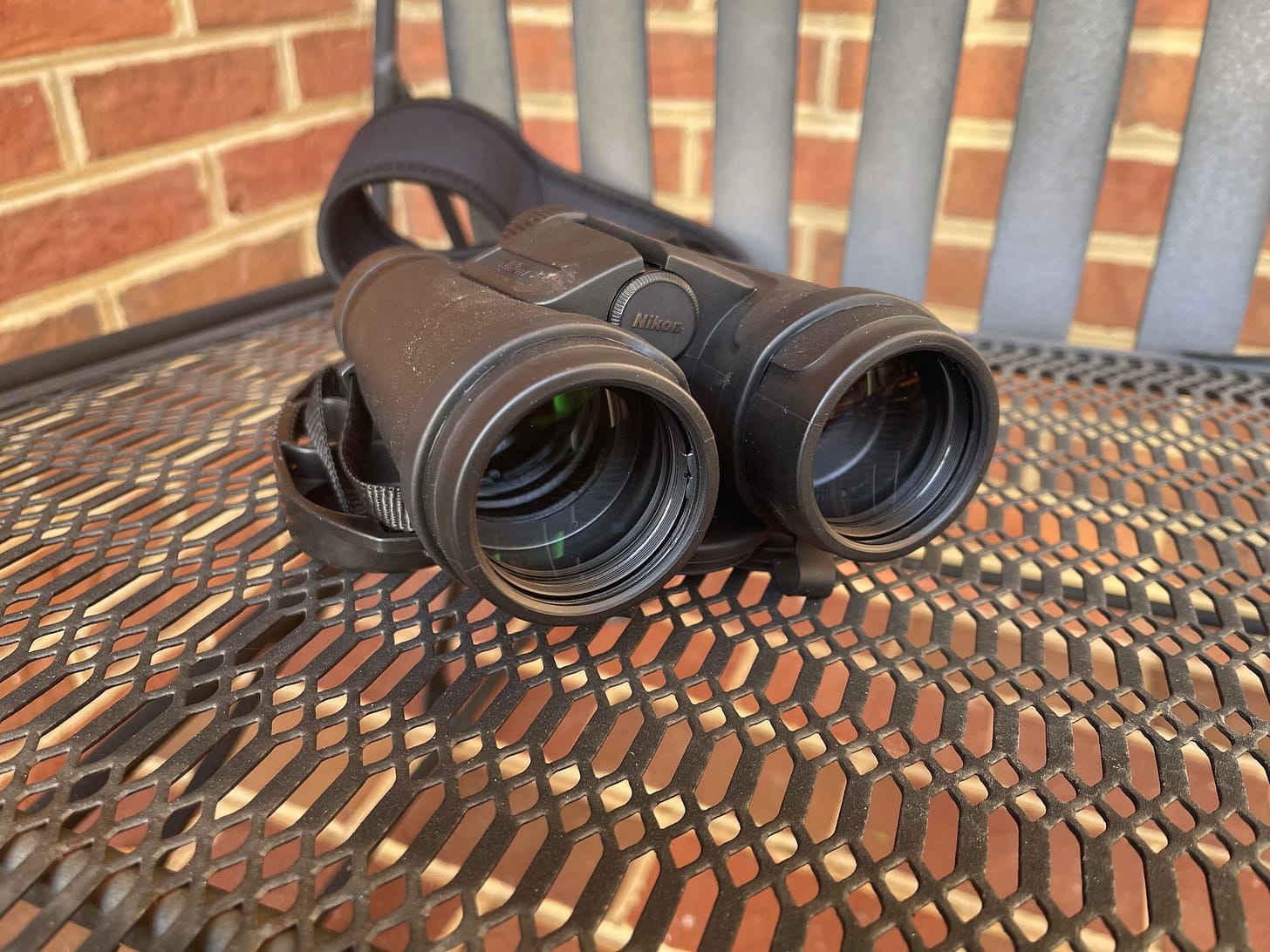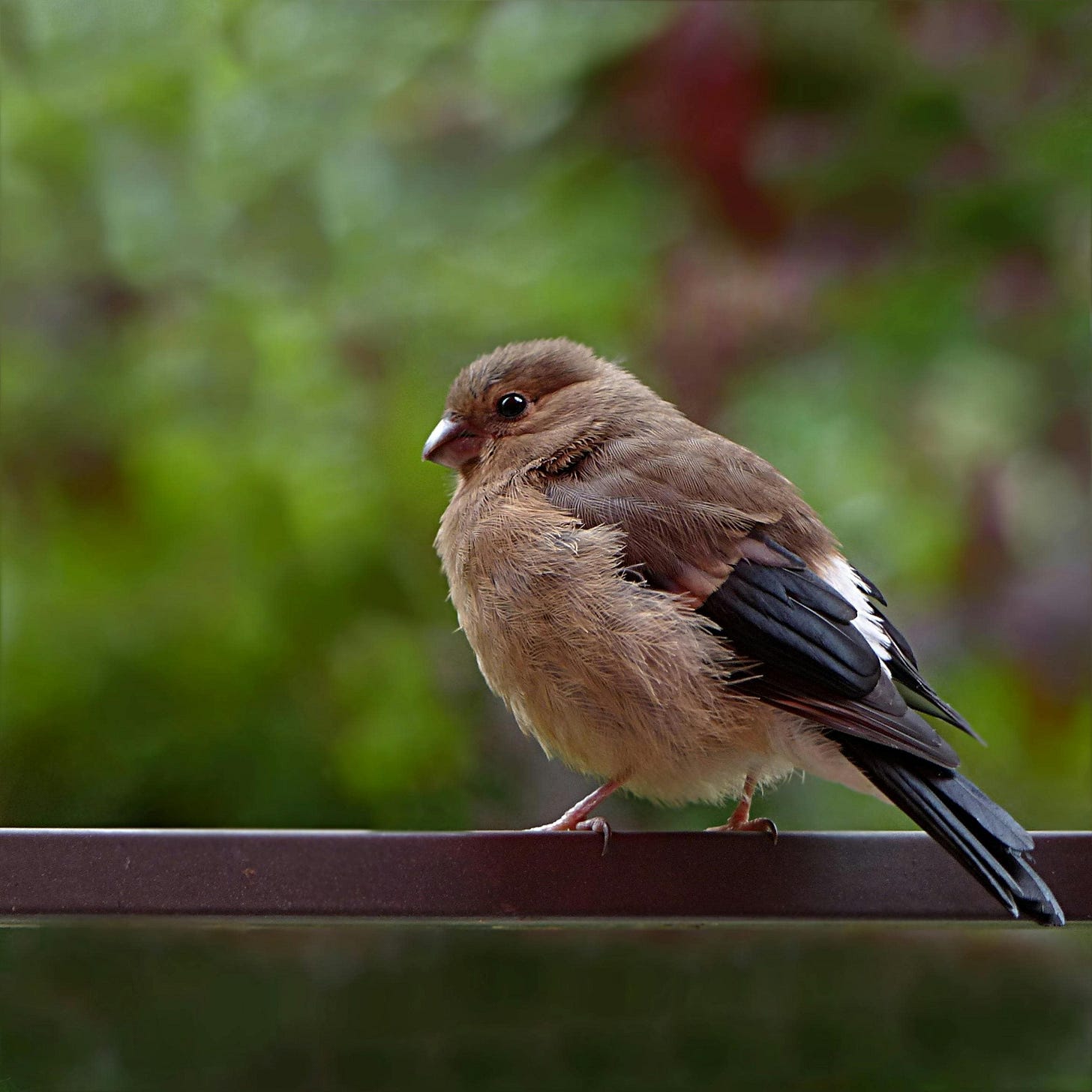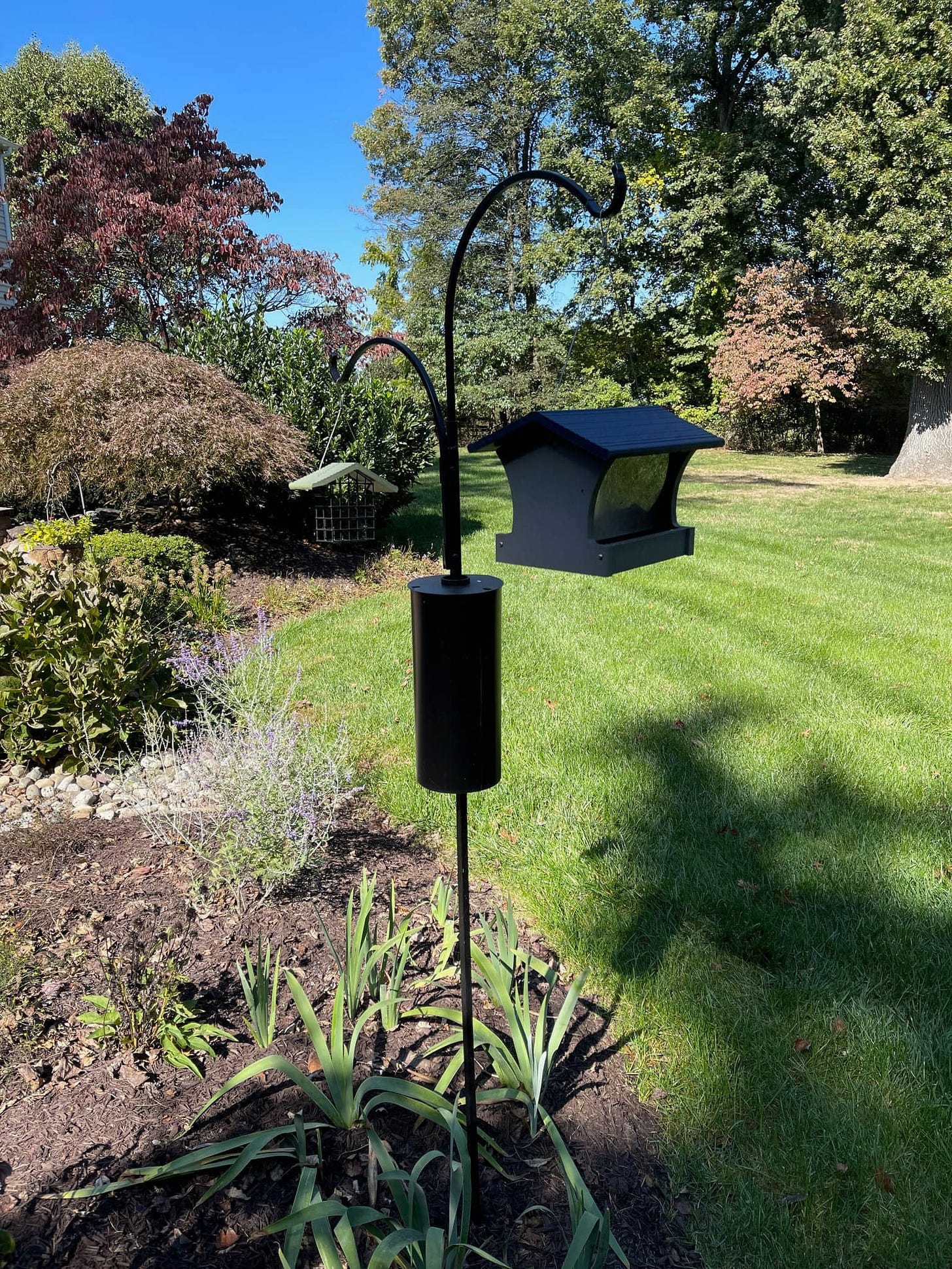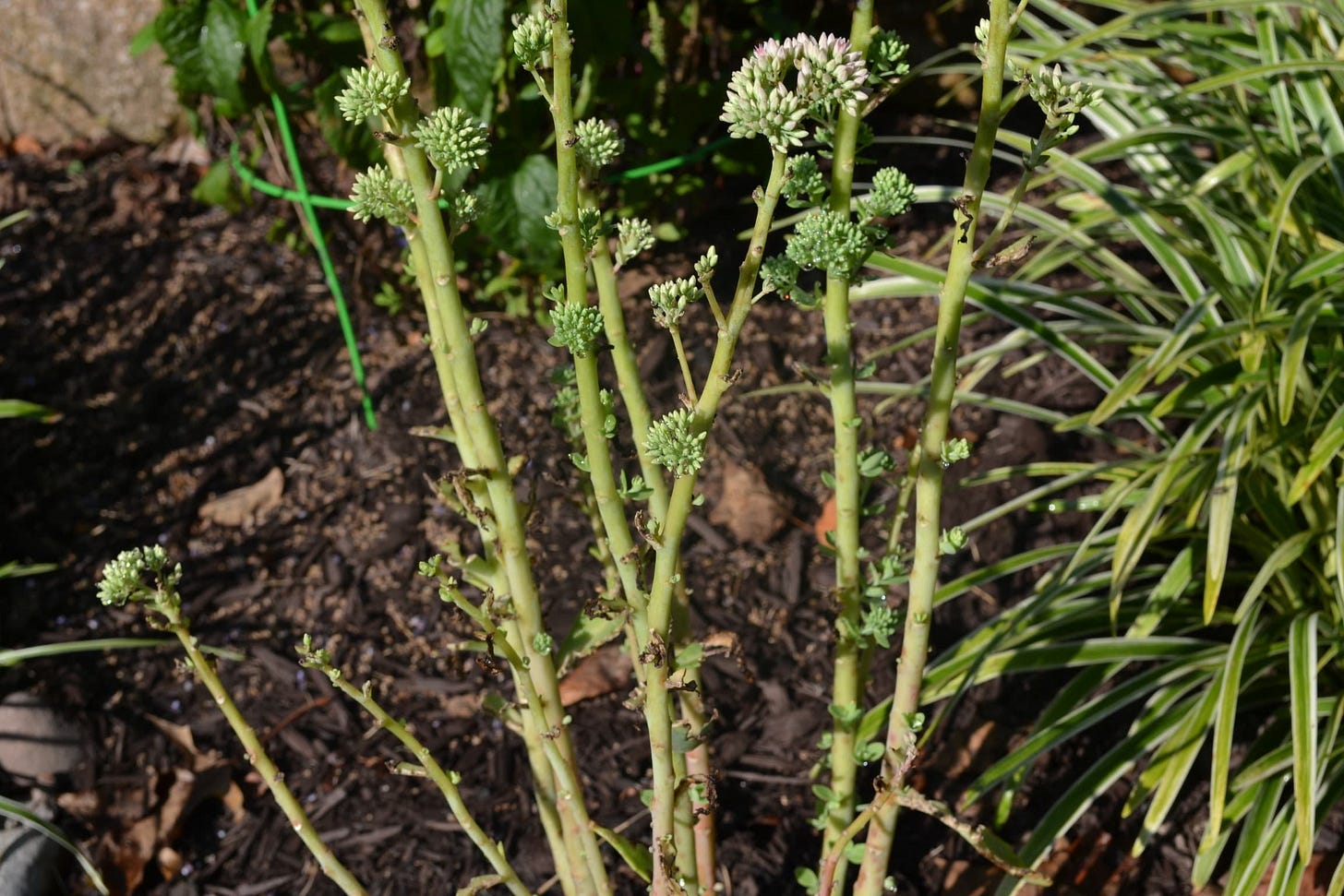My Sun Bed is Going to the Birds
It turns out the birds weren’t exactly the best guests this year, even though I tried my best to make them happy.
To be accurate, my interest in birdwatching started out as an interest in bird feeders. I wanted a tall bird feeder to add vertical interest to my sun bed, because to my eye, the bed, as you looked at it from the house, was unbearably flat. Even if you’re not particularly partial to birds, you must admit that bird feeders look cool, and I thought it would certainly add “vertical interest,” a term I hadn’t heard until I started gardening.
In my community, one of the most well-known boutique bird supply stores is called Mother Nature’s. Once you enter the store you know you are in the right place if you are looking for expert advice on birds, bird feeders, bird feed, and all other bird issues. To be expected, the staff at Mother Nature’s are all bird aficionados and their website says the owners have more than 50-years of experience. I defy you to try and stump the panel there with questions about birds and bird care. Much more interesting, and fun, is the eclectic group of customers you are likely to find in the store on any given day. Birders are strange and wonderful people. I think many were hippies back in the day, and like gardeners, they wear funny hats and clothes and use a mysterious language that only birders can understand. I like to listen to them debate the various choices of bird feed.

When I stopped by Mother Nature’s I was surprised to find out that there was a lot to learn about the benefits of bird feeder poles and the unique bird feeders they had for my consideration. I decided I didn’t want to mess around with inferior bird products in my precious new sun bed, perhaps destined to be the centerpiece of my garden. For the record, I ended up buying Dave’s No-Mess Blend of Wild Bird Food which, their guaranteed analysis says, contains not less than 20% Crude Protein, not less than 25% Crude Fat, and not more than 10% Crude Fiber. The not-so-secret ingredients are sunflower chips, shelled peanuts, and vegetable oil, all proudly manufactured by Lizzie Mae’s Birdseed and Dry Goods Co. in Millersburg, Ohio. I’ve never met him, but I think I would like Dave. Type A’s absolutely insist on No Mess.
I installed the pole near the back of the new sun bed. It has two arms that hold the two different feeders. I hung a cute little house-shaped feeder on one of the arms and filled it with Dave’s No-Mess. The other feeder holds suet, apparently the foodie woodpeckers’ gourmet choice. It also looks like a cute little house, although it's much smaller than the house next door that holds loose bird seed.
My goals when installing the pole for the feeders were two-fold. First, I didn’t want the thing to fall over. It can get windy in my backyard, and I was worried that the bird feeders would catch the wind, act like a sail, and cause the pole and the feeders to crash to the ground, making a liar out of Dave who promised the feed would be No-Mess. My second concern was that I knew squirrels would be poaching the feed if they could get at it, so I wanted to keep the feeders as far as possible from any trees, bushes, and my baby plants. I think I succeeded on both counts, but I won the battle and lost the war.

After setting up the bird feeders and filling one with seed and the other with suet, I dutifully sat back and watched for birds to arrive at their feast using my brand-new pair of Nikon Monarch M5 binoculars with 10x42 optics. The bad news is that for two to three weeks absolutely nothing happened at the bird feeders. Birds were flying around everywhere but apparently weren’t interested in Dave’s mix of sunflower seeds, shelled peanuts, and vegetable oil. The good news is that after a few weeks the birds found the bird feeder and then all hell broke loose. There was a veritable bird riot as they jockeyed to get to the seed. I find birds going about their feeding business to be endlessly entertaining. Our location near the woods assures that the birds put on quite the show as they swoop out of the nearby trees and jockey for position on the feeders. During the summer, when they were doing high-level acrobatics to get the best spot at the feeder, they were consuming a heck of a lot of bird seed. My guess is that they killed a 20-pound bag of seed in about four weeks. Way to go, Dave!
The problem was that the squirrels, and the birds, spent their time searching the ground for seeds that had fallen from the feeder, and they had little concern for my baby plants. I would often find the broken stems of flowers I had nurtured for months. To deal with this I made three changes. First, I moved the feeder closer to the back of the bed and angled it so the feeder that holds the seed is over the lawn and not over the bed. That seems to have helped. Then I changed the type of plants near the feeder, creating a bed of iris. Their stiff leaves should
stand up to damage by scavenging squirrels. Lastly, I’ve decided not to feed the birds until the plants are more established. I know this seems cruel, but the birds will probably make it through the winter without my bird feeder; my plants, however, may not. If I must make a choice between my perennials and the birds, it’s the perennials in a landslide. I’m sure the community of birders would not agree and might even share a few positive ideas on how to rectify this problem and still feed the birds. (No hating, please.)
Towards the end of the summer, I added two autumn joy sedum that promised to add color to the bed in the fall, after the summer-blooming plants began to fade. The sedum I purchased were tall and healthy, fairly bursting with leaves and flower buds that were aching to turn a pretty pink color as summer gave way to fall. Soon after planting the sedum, I noticed that the leaves were beginning to disappear. Having a long track record of killing new plants, I was worried that I was doing something wrong in caring for them. One day, about three weeks after the leaves began to vanish, and after the plants looked like they were sure to die, I was looking at the feeder from the house using my binoculars and noticed three or four little birds at each plant, feasting on the leaves. I guess they don’t call sedum succulents for nothing. I found nothing cute about the little finches (I guess they were finches) eating my plants.

Once I discovered the problem, my first solution was to purchase some bird netting and plant stakes to create a tent over the two sedum plants so that the birds couldn’t get to them. That worked, but I wasn’t happy with the way it looked. Leaves that blew into the bed would get caught in the netting, and it generally looked sloppy. I eventually moved the sedum to the fire-pit bed in another part of the garden, and so far, the birds haven’t bothered them in their new location.
I’m surprised to say that I really enjoyed watching the birds carry on at the bird feeder. Next year I’m looking forward to enjoying the birds, the iris growing under the bird feeder, and the other sun-loving plants in that bed.
Next up on the garden tour is the steps bed, where the steps ascend from the patio up to the driveway. There are beds on both sides of the steps, and plenty of stories on both sides to share. See you next post.






Looking forward to updates on how the feeders fare as birds flock to the bed later this spring.